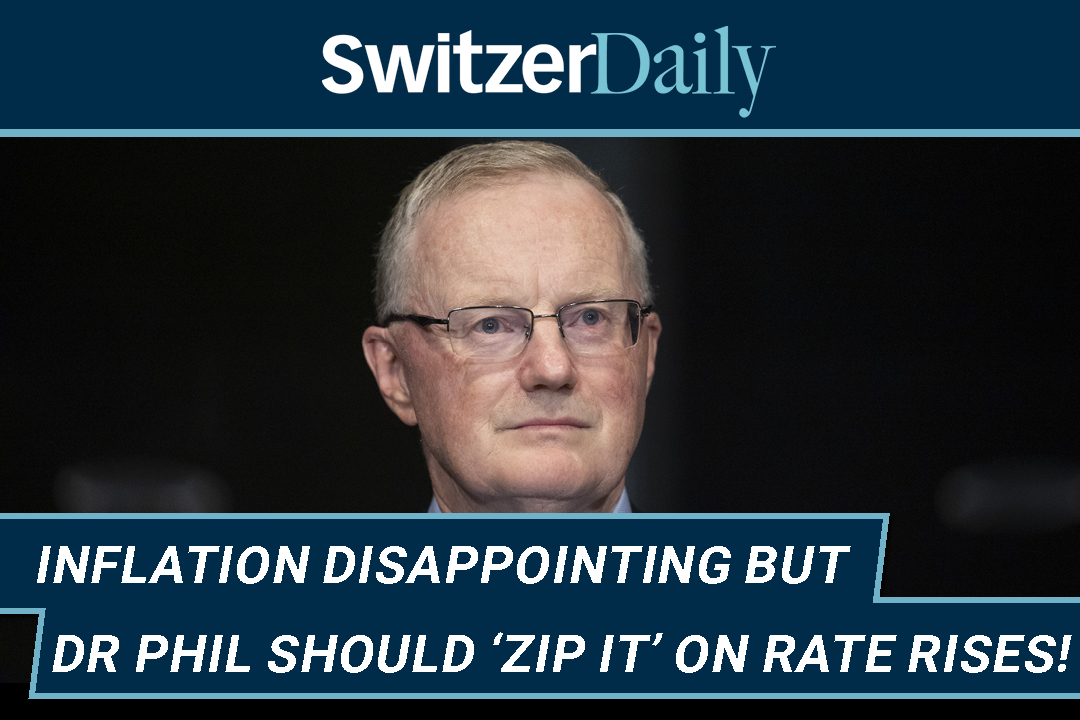

Two incidents yesterday reminded me of an old cliché that a little bit of knowledge is a dangerous thing. My thinking on this all-too-often social and historical rule of thumb made me also accept that a lot of knowledge is a safe thing and can be rewarding.
As I was driving home after a day of lots of work, I only just caught the end of a news story on the radio talking about a disappointing ‘jump’ in inflation from 6.3% to 6.8%. My passenger instantly reacted that this sounded like bad news for rate rise worriers. To that I said: “I want to see the data.”
This followed an interesting interview I did for Monday’s Switzer Investing TV show, where the co-founder and chief operating officer Peter Gray of the troubled buy now pay later business Zip Co, came to explain why Zip’s share price had plummeted from $12 to 54 cents. I also wanted him to explain if the company had potential.
By nature, I don’t invest in speculative stocks, especially when the company’s business model looks challenged. Zip has faced competition from the likes of PayPal and CBA with Klarna. Even Apple has got into the space with Apple Pay Later!
While my positivity on what inflation and the RBA might do on interest rates is based on my years of teaching and commenting on the economy, my previous negativity on Zip was based on insufficient knowledge.
At the same time, the news headlines about inflation being bad news for interest rates was dangerous because it was driven out of a lack of knowledge. On the other hand, my newfound interest in Zip as an investment — albeit a speculative and risky ‘punt’ on the stock — was because I gained knowledge from my interview with Peter Gray.
Let’s deal with the inflation number first. I hope Dr Phil and his board see it my way and not the way of headline-makers of news outlets.
The data I wanted to see was delivered by CommSec’s chief economist Craig James. It told me that consumer prices rose 0.3% in April. If you take this and multiply this monthly number by 12, you get 3.6%, which is a lot less than the annual inflation figure, which went from annual rise of 6% in March to 6.8% in April.
How could a 0.3% rise in inflation in a month push up inflation by 0.8% for the year? It just doesn’t make sense to a normal person like my passenger.
Well, this is the hocus pocus of economics. You see, the annual number is found by adding up and averaging each month’s inflation and the SMH’s Shane Wright explained the inflation rise pretty neatly. “It was pushed up largely by the impact of the Morrison government’s halving of fuel excise that slashed petrol prices in April last year,” he wrote. “That drop in prices fell out of the rolling inflation average, lifting it by 0.6 percentage points.”
Statistically, that Morrison move pushed inflation down, but that was a long time ago. So, I (and I hope the RBA) will focus on the monthly rise of only 0.3%, which saw Craig James and his CBA economics buddies declare: “Inflation has clearly peaked and is continuing to decelerate despite the uptick in the annual rate.”
If you don’t understand this statistical mumbo jumbo, you might take comfort in the old saying “lies, lies and damn statistics”!
Big drivers of the bigger-than-expected inflation number have been rising rents, pushed up by rising immigration, a lack of properties and bloody high interest rates! Also, our unstoppable desire to travel has pushed up inflation, but I bet few of those paying big airfares to go overseas are struggling with home loan repayments.
I suspect the mortgage cliff will cut spending from those now on fixed rate home loans, who soon will confront a big spike in monthly interest repayments when they’re forced on to variable rate loans.
The RBA has to pause next week and watch and be patient — that’s what knowledge tells me when you consider we’ve had 11 rate rises, making this the fastest tightening of monetary policy ever. And economists know that rate rise can take one to two years to actually work!
Back to Zip and my lack of knowledge about the BNPL company was explained to me, albeit respectfully, when Peter Gray virtually said Zip isn’t just a BNPL company. He described it as “fin-tech company”. He emphasized the BNPL start to the business was the entry channel into the finance space and the plan has always been to be more than just a BNPL business.
Being fin-tech, as well as being in the payments space, means Zip has copped a double whammy of competition from the big boys such as CBA, Apple, PayPal and other smaller players, as well as the bigger and more successful Afterpay, which is now owned by US giant Block. On top of that, the company was smashed for being in the tech space, which has been sold off since late 2021 as interest rates started to rise, that always hurt growth and tech businesses.
For me, the jury is out on the risky Zip. I might nibble a little more into the stock to reduce my losses, hoping for an eventual rebound, but when it comes to inflation and what the RBA should do, I hope Dr Phil Lowe’s and his board’s knowledge about how slow interest rate policy can work before it hits hard, makes them pause on rates next Tuesday.